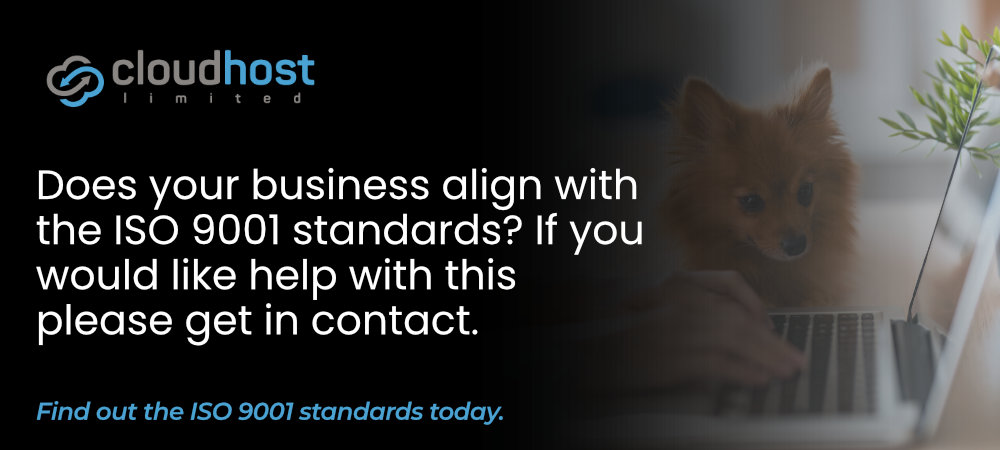
Quality Management to ISO 9001 Standards – What Is Iso 9001 and What Does Certification Involve?
12 December 2022
Meta thinks it has a great new way to save water in its data centres
19 December 2022In our last article we explored the fundamentals of the ISO 9000 quality management standards, and summarised the steps needed to achieve an ISO 9001-certified quality management system (QMS). To recap: a ‘quality management system’ is broad set of procedures, rules and policies underpinned by documentation, designed to ensure an end product or service meets a certain quality benchmark in order to achieve customer satisfaction.
ISO 9001 is the certifiable part of the ISO 9000 family, with certification widely recognised across most industries and around the globe. Improved customer satisfaction is a glaring benefit to setting up an ISO 9001-certified QMS, but doing so can be advantageous in many other ways. Additional benefits include:
Greater Dependability
ISO 9001 places great emphasis on risk management. Organisations are encouraged to think about the risks inherent in their processes, and take action to mitigate these risks where possible. Risk mitigation measures might include lining up alternative suppliers to provide goods in the event of a failed delivery, or setting up backup options for utilities such as business broadband. The result of such measures will likely be more reliable delivery of end product or services, resulting in greater customer confidence.
More Efficient business processes
The quality management system resulting from ISO 9001 certification should help structure and formalise all the key elements involved in the delivery of your service or product. The system will help delineate responsibilities and create a body of reference documents that will allow employees to make informed, independent decisions. The result will be smoother more efficient processes where everyone understands their duties and role within the greater picture.
Improved managerial oversight
The continuous evaluation and improvement required by the ISO 9001 standard will help managers understand the intricacies of business processes and enable strategic decision making that is informed by performance data. The QMS may give your business’s decision makers insights into areas of your operation that were previously unknown to them.
Happier and more motivated staff
With the necessary structures and guidance at their disposal, your QMS will give your employees everything they need to consistently meet and exceed customer expectations. Studies indicate that a lack of guidance and poor communication can offer inhibit the ability of staff to work effectively, leaving employees feeling exasperated and unmotivated. An ISO 9001-certified quality management system will enable your team to respond to a wide range of situations independently, eliminating the need for excessive delegation across the company hierarchy. This will help staff feeling empowered and able to respond to the vast majority of issues without supervision.
Reduced Insurance Costs
Because ISO 9001 certification demonstrates ‘risk mindfulness’ and an organisation’s ability to manage the risks it faces, insurers often provide lower premiums to certified organisations.
A credibility boost
ISO 9001 is the world’s most widely-recognised quality management standard, with recognition spanning all sectors and certification applicable to businesses of all sizes. ISO 9001 certification is an unparalleled mark of professionalism, a badge proclaiming commitment to an exceptional customer experience and a drive for continuous improvement. Certification will improve your organisation’s status in the eyes of existing and potential customers alike.
The prospect of new opportunities
For many organisations seeking certification, this is perhaps the most enticing benefit. In the tendering process for both public and private sector contracts, an enquiry about ISO 9001 certification is highly likely to feature – often even at pre-qualification stage. Certification will give your organisation a clear advantage against non-certified competitors, as they’ll face the challenge of having to prove that their systems and processes for managing quality outcomes are a match for yours, both in terms of breadth and standard.
ISO 9001 certification demonstrates to prospects that your organisation has structures in place to deliver on contractual commitments consistently, and that you’ve given extensive thought to operating within your regulatory framework. This will inspire confidence in potential clients and could set your organisation on the path to commercial success.
The part your IT system can play in the quality management process…
At this point it’s natural to think: how is any of this relevant to my business’s IT system?
Quality management processes and IT systems have more in common than first meets the eye: they both seek to streamline business processes and aid in the efficient delivery of a high quality product outcome.
By optimising your IT to boost productivity, enable seamless communication (particularly client engagement) and structure and streamline processes using technologies like business process automation (BPA), you can create a technology stack that helps facilitate your quality management objectives.
Let’s explore a few of the ways your IT can assist quality management processes, with direct reference to the stipulations of ISO 9001:2015.
Requirement 82) Clause 7.1.3
“Provide and maintain infrastructure necessary to the functioning of processes.”
This item requires the installation and ongoing maintenance of hardware and software components required to evaluate and align product/service outcomes with target quality metrics.
What implications does this have for my IT?
To satisfy this requirement, you’ll want to be operating using technology that is flexible, dependable, modern and in line with customer expectations.
In order to monitor processes to ensure quality, you could consider deploying IoT devices in certain settings – particularly useful in manufacturing processes where material and assembly quality must be closely observed.
For businesses operating in the creative sector this requirement might mean utilising the latest editing/video production software to ensure the end product is in line with industry standards and customer expectations.
For professional services businesses, this requirement could mean granting clients access to multiple communication portals for a more engaging and involving customer relationship, as well as technologies that allow customers to carry out admin tasks remotely, such as secure document upload portals and e-signature capabilities.
Requirement 106) Clause 7.4 d
“Define how to communicate.”
This requirement forms part of the planning phase and requires organisations to identify the communication channels necessary to achieve a high-quality customer experience.
What implications does this have for my IT?
Think about your complaints handling process and the structures necessary in ensuring swift issue resolution. Consider whether your phone system has the features necessary to handle a high volume of calls and establish a clearly defined process (backed by automation) for handling support requests.
Consider the expectations your customers have in terms of their ability to contact you. If business trips make it hard for customers to keep in touch, a hosted VoIP phone system might help provide the out-of-office connectivity you and your clients need. If managing customer accounts is a clunky and disjointed affair, a customer relationship management system (CRM) could be of benefit, allowing you to consolidate customer data in one place for a smoother customer support experience. If remote engagement is something you struggle with (with customers, partners and remote employees) consider investing in a videoconferencing platform and associated technologies such as webcams, to help keep remote parties in the loop.
Requirement 114) Clause 7.5.3.1.b
“Control the protection of the documented information.”
In order to achieve ISO 9001 certification, the standard requires an extensive body of supporting documentation to support the established quality management processes. The requirement above relates to this documentation, requiring control measures to be established to protect and secure this information.
What implications does this have for my IT?
To protect sensitive documents, a series of checks and balances – both technical and organisational – should be established to prevent unauthorised access and reliably authenticate the identities of individuals permitted to view company files. Authentication protocols featuring more advanced identity verification methods (such as multi-factor authentication) than traditional username/password combinations could be implemented to safeguard sensitive information, and read-only permissions could be enforced for vital documents to prevent unauthorised editing. Other controls such as ‘download blocking’ can help prevent further file misuse.
More generally, security measure such as encryption could be used to protect information travelling across insecure networks, and firewall protections and anti-virus programmes could be used to keep hacker’s away from sensitive data.
Requirement 206) Clause 8.5.1
“The organization shall implement production and service provision under controlled conditions. Controlled conditions shall include, as applicable: … g) the implementation of actions to prevent human error;”
This item requires organisations to take steps to mitigate against human error in the delivery of the end product or service.
What implications does this have for my IT?
Technology can be useful in structuring processes and helping to ensure that procedures are followed to the letter. Workflow management tools for example can be helpful in ensuring tasks follow a set procedure, that deadlines are strictly adhered to, that no phase of the task gets overlooked and that no data goes missing in the process timeline.
Automation has a key role to play in minimising human error and can simultaneously reduce the burden of repetitive, manual tasks that have little value in and of themselves. Roles for automation include in the billing process, customer service, order processing, sales, marketing and much more.
Conclusion
Creating an ISO 9001 compliant quality management system requires commitment and a willingness to examine and optimise every process in your organisation that has a bearing on the quality of the product or service you provide. For businesses willing to take on the challenge the rewards can be significant: from the ability to win more contracts to satisfied clients that have faith in your business’s ability to deliver.
IT has a critical role to play when it comes to developing sound quality management processes, from leading-edge business communication solutions that keep all parties connected to IoT (internet of things) technologies and automation platforms that keep human error to a minimum and aid in achieving quality objectives.





